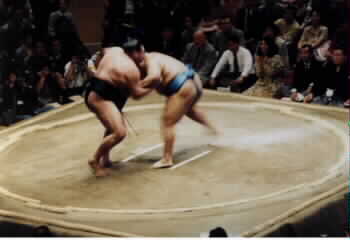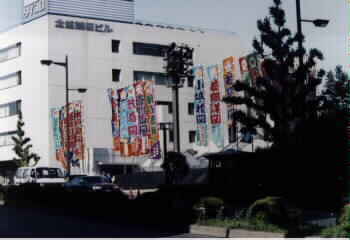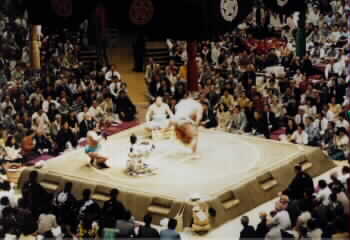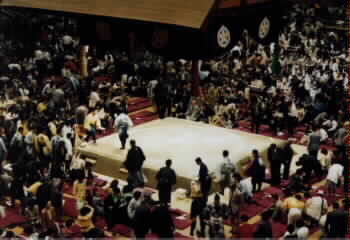
This is traditional Japanese wrestling and in 1909 was established as the national sport. In ancient times, it was practiced as agricultural and Shinto rituals, so it still today includes many ceremonial elements. In a Sumo match, two wrestlers wearing only a Sumo wrestler's loincloth enter the ring, and they fight until one either leaves the ring or touches the ground with any part of his body other than the bottom of his feet. The Japan Sumo Association puts on six annual tournaments of the professional Sumo per year, and these are broadcast on both television and redio.
Since the 1960s, overseas tours of the tournaments of
the professional Sumo have frequently been made, and have become so popular
internationally that an English Sumo magazine called "Sumo World"
is avidly read in a number of countries. In addition, the accomplishments
of foreign wrestlers recently have attracted attention.
Sumo Yokozuna
Sumo-Beya Dohyoiri
picture 1 picture 2
picture 3 picture 4
Back to Cultures




Grand Champion : Yokozuna is the highest rank for Sumo
wrestlers. (The rope that wrestlers of Yokozuna wear on the thier belt
an elaborately embroidered apron also called Yokozuna, is a modification
of a sacred Shinto rope. Only those wrestlers who win two consecutive tournameents,
or achieve similar results as the second highest rank can become Yokozuna.
The professional Sumo have a history of more than two hundred years, but,
with only 64 wrestlers having been promoted to Yokozuna (by August 1993),
it is an exceedingly narrow gate to that rank. In 1993, Akebono, an American,
was promoted as the 64th Yokozuna and became the first foreigner to reach
the top rank.
Sumo Yokozuna
Sumo-Beya Dohyoiri
picture 1 picture 2
picture 3 picture 4
Back to Cultures
Sumo stables : The wrestlers of the professional Sumo
from the different stables contest each other. The wrestlers always belong
to Sumo-beya and practice daily under Oyakata who is a stable master. Sumo-beya
form a solid vertical relationship between master and disciple, which resembles
the situation of human relationships in the old feudal society. Those lowest
on the ranking list are assigned to serve those higher up, doing such things
as making the Sumo wrestlers' dish. The madam of the stable, who is a wife
of the stable master, fulfills a large role, carrying out negotiations
with the outside and looking after the problems of the wrestlers. Theyare
not the only ones who belong to Sumo-beya, there are also stables with
Sumo referees, callers, professional Sumo hairdressers, and people who
do promotions for provincial tours and do manual labor.
Sumo Yokozuna
Sumo-Beya Dohyoiri
picture 1 picture 2
picture 3 picture 4
Back to Cultures
Display of Sumo wrestlers in the ring : To indicate their
purity of body and to pledge to the god of the ring that they will fight
fairly, wrestlers of the professional Sumo ranked junior grade and above
participate in Do hyouiri before they enter the ring in order of rank and
make a circle. Grand champions, however, are each accompannied by a sword
besrer and a herald and perform the ceremony one at a time. The individual
character of each grand champion is expressed particularly through the
Dohyoiri, in which one can see the splendor and appeal of their respective
styles.
Sumo Yokozuna
Sumo-Beya Dohyoiri
picture 1 picture 2
picture 3 picture 4
Back to Cultures